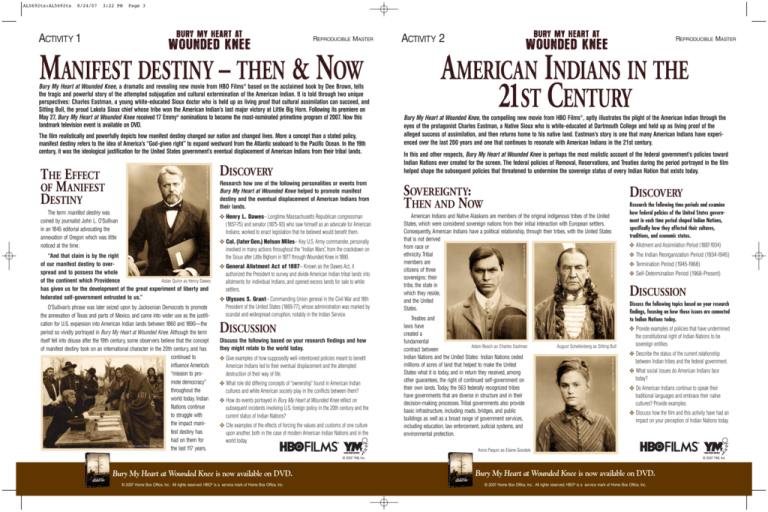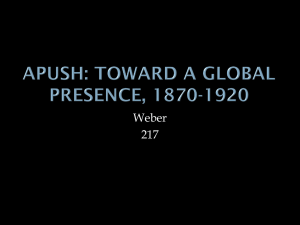
AL5692tx:AL5692tx
8/24/07
3:22 PM
Page 3
ACTIVITY 1
REPRODUCIBLE MASTER
MANIFEST DESTINY – THEN & NOW
Bury My Heart at Wounded Knee, a dramatic and revealing new movie from HBO Films based on the acclaimed book by Dee Brown, tells
the tragic and powerful story of the attempted subjugation and cultural extermination of the American Indian. It is told through two unique
perspectives: Charles Eastman, a young white-educated Sioux doctor who is held up as living proof that cultural assimilation can succeed, and
Sitting Bull, the proud Lakota Sioux chief whose tribe won the American Indian’s last major victory at Little Big Horn. Following its premiere on
May 27, Bury My Heart at Wounded Knee received 17 Emmy® nominations to become the most-nominated primetime program of 2007. Now this
landmark television event is available on DVD.
®
The film realistically and powerfully depicts how manifest destiny changed our nation and changed lives. More a concept than a stated policy,
manifest destiny refers to the idea of America’s “God-given right” to expand westward from the Atlantic seaboard to the Pacific Ocean. In the 19th
century, it was the ideological justification for the United States government’s eventual displacement of American Indians from their tribal lands.
Bury My Heart at Wounded Knee / HBO
THE EFFECT
OF MANIFEST
DESTINY
Research how one of the following personalities or events from
Bury My Heart at Wounded Knee helped to promote manifest
destiny and the eventual displacement of American Indians from
their lands.
✜ Henry L. Dawes– Longtime Massachusetts Republican congressman
(1857-75) and senator (1875-93) who saw himself as an advocate for American
Indians; worked to enact legislation that he believed would benefit them.
✜ Ulysses S. Grant– Commanding Union general in the Civil War and 18th
President of the United States (1869-77), whose administration was marked by
scandal and widespread corruption, notably in the Indian Service.
DISCUSSION
Discuss the following based on your research findings and how
they might relate to the world today.
✜ Give examples of how supposedly well-intentioned policies meant to benefit
American Indians led to their eventual displacement and the attempted
destruction of their way of life.
✜ What role did differing concepts of “ownership” found in American Indian
cultures and white American society play in the conflicts between them?
✜ How do events portrayed in Bury My Heart at Wounded Knee reflect on
subsequent incidents involving U.S. foreign policy in the 20th century and the
current status of Indian Nations?
✜ Cite examples of the effects of forcing the values and customs of one culture
upon another, both in the case of modern American Indian Nations and in the
world today.
Bury My Heart at Wounded Knee, the compelling new movie from HBO Films®, aptly illustrates the plight of the American Indian through the
eyes of the protagonist Charles Eastman, a Native Sioux who is white-educated at Dartmouth College and held up as living proof of the
alleged success of assimilation, and then returns home to his native land. Eastman’s story is one that many American Indians have experienced over the last 200 years and one that continues to resonate with American Indians in the 21st century.
In this and other respects, Bury My Heart at Wounded Knee is perhaps the most realistic account of the federal government’s policies toward
Indian Nations ever created for the screen. The federal policies of Removal, Reservations, and Treaties during the period portrayed in the film
helped shape the subsequent policies that threatened to undermine the sovereign status of every Indian Nation that exists today.
SOVEREIGNTY:
THEN AND NOW
DISCOVERY
Research the following time periods and examine
how federal policies of the United States government in each time period shaped Indian Nations,
specifically how they affected their cultures,
traditions, and economic status.
American Indians and Native Alaskans are members of the original indigenous tribes of the United
States, which were considered sovereign nations from their initial interaction with European settlers.
Consequently, American Indians have a political relationship, through their tribes, with the United States
that is not derived
from race or
ethnicity. Tribal
members are
citizens of three
sovereigns: their
tribe, the state in
which they reside,
and the United
States.
Treaties and
laws have
created a
fundamental
Adam Beach as Charles Eastman
contract between
Indian Nations and the United States: Indian Nations ceded
millions of acres of land that helped to make the United
States what it is today, and in return they received, among
other guarantees, the right of continued self-government on
their own lands. Today, the 563 federally recognized tribes
have governments that are diverse in structure and in their
decision-making processes. Tribal governments also provide
basic infrastructure, including roads, bridges, and public
buildings as well as a broad range of government services,
including education, law enforcement, judicial systems, and
environmental protection.
✜ Allotment and Assimilation Period (1887-1934)
✜ The Indian Reorganization Period (1934-1945)
✜ Termination Period (1945-1968)
✜ Self-Determination Period (1968-Present)
DISCUSSION
Discuss the following topics based on your research
findings, focusing on how these issues are connected
to Indian Nations today.
August Schellenberg as Sitting Bull
Bury My Heart at Wounded Knee / HBO
O’Sullivan’s phrase was later seized upon by Jacksonian Democrats to promote
the annexation of Texas and parts of Mexico, and came into wider use as the justification for U.S. expansion into American Indian lands between 1860 and 1890—the
period so vividly portrayed in Bury My Heart at Wounded Knee. Although the term
itself fell into disuse after the 19th century, some observers believe that the concept
of manifest destiny took on an international character in the 20th century, and has
continued to
influence America’s
“mission to promote democracy”
throughout the
world today. Indian
Nations continue
to struggle with
the impact manifest destiny has
had on them for
Bury My Heart at Wounded Knee
the last 117 years.
✜ General Allotment Act of 1887– Known as the Dawes Act, it
authorized the President to survey and divide American Indian tribal lands into
allotments for individual Indians, and opened excess lands for sale to white
settlers.
AMERICAN INDIANS IN THE
21ST CENTURY
Bury My Heart at Wounded Knee / HBO
“And that claim is by the right
of our manifest destiny to overspread and to possess the whole
of the continent which Providence
Aidan Quinn as Henry Dawes
has given us for the development of the great experiment of liberty and
federated self-government entrusted to us.”
✜ Col. (later Gen.) Nelson Miles– Key U.S. Army commander, personally
involved in many actions throughout the “Indian Wars”, from the crackdown on
the Sioux after Little Bighorn in 1877 through Wounded Knee in 1890.
REPRODUCIBLE MASTER
Bury My Heart at Wounded Knee / HBO
The term manifest destiny was
coined by journalist John L. O’Sullivan
in an 1845 editorial advocating the
annexation of Oregon which was little
noticed at the time:
DISCOVERY
ACTIVITY 2
✜ Provide examples of policies that have undermined
the constitutional right of Indian Nations to be
sovereign entities.
✜ Describe the status of the current relationship
between Indian tribes and the federal government.
✜ What social issues do American Indians face
today?
✜ Do American Indians continue to speak their
traditional languages and embrace their native
cultures? Provide examples.
✜ Discuss how the film and this activity have had an
impact on your perception of Indian Nations today.
/ HBO
YOUNG MINDS INSPIRED
Anna Paquin as Elaine Goodale
© 2007 YMI, Inc.
YOUNG MINDS INSPIRED
© 2007 YMI, Inc.
Bury My Heart at Wounded Knee is now available on DVD.
Bury My Heart at Wounded Knee is now available on DVD.
© 2007 Home Box Office, Inc. All rights reserved. HBO® is a service mark of Home Box Office, Inc.
© 2007 Home Box Office, Inc. All rights reserved. HBO® is a service mark of Home Box Office, Inc.
AL5692tx:AL5692tx
8/24/07
3:22 PM
Page 3
ACTIVITY 1
REPRODUCIBLE MASTER
MANIFEST DESTINY – THEN & NOW
Bury My Heart at Wounded Knee, a dramatic and revealing new movie from HBO Films based on the acclaimed book by Dee Brown, tells
the tragic and powerful story of the attempted subjugation and cultural extermination of the American Indian. It is told through two unique
perspectives: Charles Eastman, a young white-educated Sioux doctor who is held up as living proof that cultural assimilation can succeed, and
Sitting Bull, the proud Lakota Sioux chief whose tribe won the American Indian’s last major victory at Little Big Horn. Following its premiere on
May 27, Bury My Heart at Wounded Knee received 17 Emmy® nominations to become the most-nominated primetime program of 2007. Now this
landmark television event is available on DVD.
®
The film realistically and powerfully depicts how manifest destiny changed our nation and changed lives. More a concept than a stated policy,
manifest destiny refers to the idea of America’s “God-given right” to expand westward from the Atlantic seaboard to the Pacific Ocean. In the 19th
century, it was the ideological justification for the United States government’s eventual displacement of American Indians from their tribal lands.
Bury My Heart at Wounded Knee / HBO
THE EFFECT
OF MANIFEST
DESTINY
Research how one of the following personalities or events from
Bury My Heart at Wounded Knee helped to promote manifest
destiny and the eventual displacement of American Indians from
their lands.
✜ Henry L. Dawes– Longtime Massachusetts Republican congressman
(1857-75) and senator (1875-93) who saw himself as an advocate for American
Indians; worked to enact legislation that he believed would benefit them.
✜ Ulysses S. Grant– Commanding Union general in the Civil War and 18th
President of the United States (1869-77), whose administration was marked by
scandal and widespread corruption, notably in the Indian Service.
DISCUSSION
Discuss the following based on your research findings and how
they might relate to the world today.
✜ Give examples of how supposedly well-intentioned policies meant to benefit
American Indians led to their eventual displacement and the attempted
destruction of their way of life.
✜ What role did differing concepts of “ownership” found in American Indian
cultures and white American society play in the conflicts between them?
✜ How do events portrayed in Bury My Heart at Wounded Knee reflect on
subsequent incidents involving U.S. foreign policy in the 20th century and the
current status of Indian Nations?
✜ Cite examples of the effects of forcing the values and customs of one culture
upon another, both in the case of modern American Indian Nations and in the
world today.
Bury My Heart at Wounded Knee, the compelling new movie from HBO Films®, aptly illustrates the plight of the American Indian through the
eyes of the protagonist Charles Eastman, a Native Sioux who is white-educated at Dartmouth College and held up as living proof of the
alleged success of assimilation, and then returns home to his native land. Eastman’s story is one that many American Indians have experienced over the last 200 years and one that continues to resonate with American Indians in the 21st century.
In this and other respects, Bury My Heart at Wounded Knee is perhaps the most realistic account of the federal government’s policies toward
Indian Nations ever created for the screen. The federal policies of Removal, Reservations, and Treaties during the period portrayed in the film
helped shape the subsequent policies that threatened to undermine the sovereign status of every Indian Nation that exists today.
SOVEREIGNTY:
THEN AND NOW
DISCOVERY
Research the following time periods and examine
how federal policies of the United States government in each time period shaped Indian Nations,
specifically how they affected their cultures,
traditions, and economic status.
American Indians and Native Alaskans are members of the original indigenous tribes of the United
States, which were considered sovereign nations from their initial interaction with European settlers.
Consequently, American Indians have a political relationship, through their tribes, with the United States
that is not derived
from race or
ethnicity. Tribal
members are
citizens of three
sovereigns: their
tribe, the state in
which they reside,
and the United
States.
Treaties and
laws have
created a
fundamental
Adam Beach as Charles Eastman
contract between
Indian Nations and the United States: Indian Nations ceded
millions of acres of land that helped to make the United
States what it is today, and in return they received, among
other guarantees, the right of continued self-government on
their own lands. Today, the 563 federally recognized tribes
have governments that are diverse in structure and in their
decision-making processes. Tribal governments also provide
basic infrastructure, including roads, bridges, and public
buildings as well as a broad range of government services,
including education, law enforcement, judicial systems, and
environmental protection.
✜ Allotment and Assimilation Period (1887-1934)
✜ The Indian Reorganization Period (1934-1945)
✜ Termination Period (1945-1968)
✜ Self-Determination Period (1968-Present)
DISCUSSION
Discuss the following topics based on your research
findings, focusing on how these issues are connected
to Indian Nations today.
August Schellenberg as Sitting Bull
Bury My Heart at Wounded Knee / HBO
O’Sullivan’s phrase was later seized upon by Jacksonian Democrats to promote
the annexation of Texas and parts of Mexico, and came into wider use as the justification for U.S. expansion into American Indian lands between 1860 and 1890—the
period so vividly portrayed in Bury My Heart at Wounded Knee. Although the term
itself fell into disuse after the 19th century, some observers believe that the concept
of manifest destiny took on an international character in the 20th century, and has
continued to
influence America’s
“mission to promote democracy”
throughout the
world today. Indian
Nations continue
to struggle with
the impact manifest destiny has
had on them for
Bury My Heart at Wounded Knee
the last 117 years.
✜ General Allotment Act of 1887– Known as the Dawes Act, it
authorized the President to survey and divide American Indian tribal lands into
allotments for individual Indians, and opened excess lands for sale to white
settlers.
AMERICAN INDIANS IN THE
21ST CENTURY
Bury My Heart at Wounded Knee / HBO
“And that claim is by the right
of our manifest destiny to overspread and to possess the whole
of the continent which Providence
Aidan Quinn as Henry Dawes
has given us for the development of the great experiment of liberty and
federated self-government entrusted to us.”
✜ Col. (later Gen.) Nelson Miles– Key U.S. Army commander, personally
involved in many actions throughout the “Indian Wars”, from the crackdown on
the Sioux after Little Bighorn in 1877 through Wounded Knee in 1890.
REPRODUCIBLE MASTER
Bury My Heart at Wounded Knee / HBO
The term manifest destiny was
coined by journalist John L. O’Sullivan
in an 1845 editorial advocating the
annexation of Oregon which was little
noticed at the time:
DISCOVERY
ACTIVITY 2
✜ Provide examples of policies that have undermined
the constitutional right of Indian Nations to be
sovereign entities.
✜ Describe the status of the current relationship
between Indian tribes and the federal government.
✜ What social issues do American Indians face
today?
✜ Do American Indians continue to speak their
traditional languages and embrace their native
cultures? Provide examples.
✜ Discuss how the film and this activity have had an
impact on your perception of Indian Nations today.
/ HBO
YOUNG MINDS INSPIRED
Anna Paquin as Elaine Goodale
© 2007 YMI, Inc.
YOUNG MINDS INSPIRED
© 2007 YMI, Inc.
Bury My Heart at Wounded Knee is now available on DVD.
Bury My Heart at Wounded Knee is now available on DVD.
© 2007 Home Box Office, Inc. All rights reserved. HBO® is a service mark of Home Box Office, Inc.
© 2007 Home Box Office, Inc. All rights reserved. HBO® is a service mark of Home Box Office, Inc.








